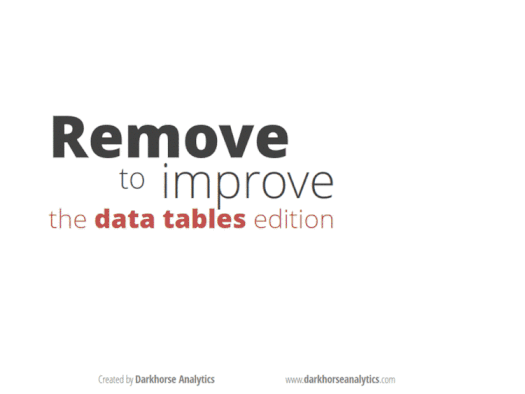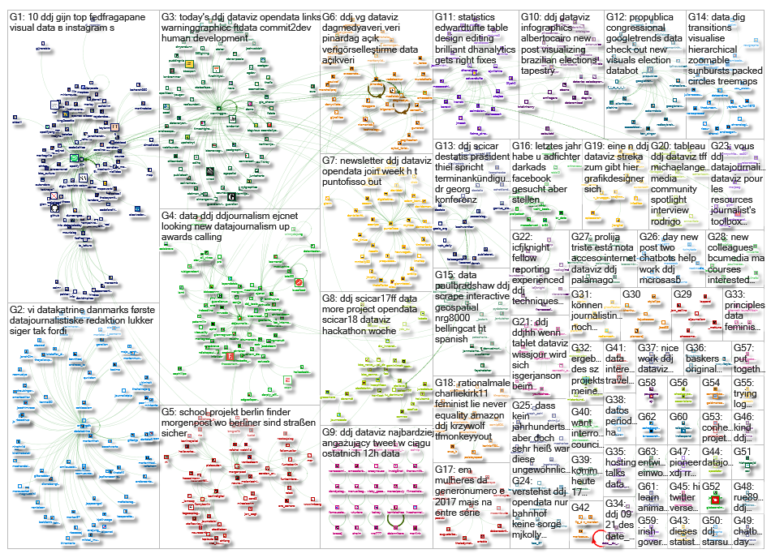What’s the global data journalism community tweeting about this week? Our NodeXL #ddj mapping from Sept 17 to 23 finds numerous data to map, from @NatGeo‘s migration of billions of birds to @morgenpost‘s Berlin schools and @A24COM‘s internet access in Argentina. There’s also @dhanalytics‘ tips on improving data tables and @mcrosasb on two useful chatbots.
Mapping Billions of Birds
National Geographic’s senior graphics editor Brian Jacobs describes in detail the process behind creating an impressive data-driven feature on the journey of migratory birds. He writes about the challenges and solutions in dealing with the cartography, geographic processing, composition and effects, labelling, animations, data acquisition and more.
Your weekend reading should include this incredibly in-depth piece on using satellite imagery and also following a hawk. https://t.co/3YG4xwqjoD
— OpenNews Source (@source) September 21, 2018
Make a Guess About Climate Change
SVT News created a “make a guess” interactive on climate change effects on the globe. See if you can guess the temperature increase, sea level rise and the size of the shrinking Arctic correctly. (In Swedish.)
— Marie Liselott Skåne_tösa_bit ♿📎☮♌👠♀️🏳️🌈 (@MarieLiselott) September 15, 2018
Less Is More Tables
This GIF from 2014 is a good reminder that when it comes to data tables: Less is more effective, attractive and impactful. Follow the step-by-step tutorial to remove excess visual distractions and move text and figures to improve your table.

Useful Chatbots
Journalist Maria Crosas writes about two chatbots on Facebook Messenger: SummarizeBot, which extracts the most important information in articles, images with text or audio files; and FacterBot, which helps to detect false stories on the internet.
NEW POST: These two #chatbots will help you on your day-to-day work https://t.co/8U3z036AC4 #ddj pic.twitter.com/rNBOp4Y8hK
— Maria Crosas (@mcrosasb) September 18, 2018
Mapping Schools in Berlin
Time to sign up your child for school in Berlin? Berliner Morgenpost built an interactive of all the schools in the city. Filter by district, school type, profile, language and special offerings. (In German.)
Du wohnst in #Berlin und dein Kind soll bald auf die #Schule? Dann hilft vielleicht das hier: https://t.co/6f897jNoud #Schulfinder #ddj #dataviz pic.twitter.com/OcU78UMNvR
— Manuel Bogner (@ManuelBogner) September 20, 2018
Mapping Internet Access in Argentina
Data journalist Ignacio Ferreiro mapped the internet access in Argentina and found the Patagonian provinces had the worst connections. (In Spanish.)
Que prolija y que triste está nota.
Acceso a internet en 🇦🇷#dataviz #ddj https://t.co/vZHyLgq5q7— Pablo H. Paladino (@palamago) September 21, 2018
Google Trends on Brazilian Election
The Brazilian presidential election will take place on October 7th and millions of Brazilians are Googling information on the candidates running for the post. Discover which topics aroused the most interest through Google Trends’ lenses in this project by Carol Cavaleiro, Thais Viana and Tainá Simões. (In Portuguese.)
Visualizing the Brazilian elections #dataviz #journotools https://t.co/vuHYPQcCKR pic.twitter.com/OZcgZC351I
— CentreforJournalism (@CfJKent) September 19, 2018
Scraping Geospatial Data
Bellingcat prepared a step-by-step tutorial on how to scrape geospatial data, including the tools needed to do it. Scraping such data might be useful for further analysis, geolocating footage or archiving purposes.
. @Bellingcat provides incredible tutorials about the forensic investigation with open source data. https://t.co/hX8hSrc5bs https://t.co/MsogQ9hJ8p
— Vlad Markov (@vmarkov) September 25, 2018
US Election DataBot Updated
ProPublica’s Election DataBot tool, launched in 2016, has been updated with more data and an improved interface. Find newsworthy information about the election quickly and in real time.
Today I'm proud to show off the work that @lamarr_lemee & @mbgerring have been putting in to make Election DataBot even better. We've got a much-improved homepage, more data & more ways for you to see campaign activity:https://t.co/EMiDuROnCD pic.twitter.com/fEDMODrY3L
— Derek Willis (@derekwillis) September 18, 2018
Tapestry Conference 2018
The sixth Tapestry Conference, an event to advance interactive online data storytelling, will be held at the University of Miami on November 29 and 30. It’s keynote speakers include the Guardian’s data editor Mona Chalabi, University of Michigan assistant professor of information Matthew Kay and Netflix’s senior data visualisation engineer Elijah Meeks.
And even if I can't be there, I'm grateful to @albertocairo and @eagereyes for making sure there is, indeed, a Tapestry Conference 2018. It's an unforgettable, incredibly valuable experience, and I hope that if you can avail yourself of it, you do so. https://t.co/5za07DdxTc /end
— Mike Cisneros (@mikevizneros) September 24, 2018
Thanks, once again, to Marc Smith of Connected Action for gathering the links and graphing them. NOTE: Top Ten #ddj will take a short hiatus for two weeks as GIJN will be in Seoul, Korea for the 3rd Asian Investigative Journalism Conference. The Top Ten #ddj list will resume on October 18, 2018.
 Eunice Au is GIJN’s program coordinator. Previously, she was a Malaysia correspondent for Singapore’s The Straits Times, and a journalist at the New Straits Times. She has also written for The Sun, Malaysian Today and Madam Chair.
Eunice Au is GIJN’s program coordinator. Previously, she was a Malaysia correspondent for Singapore’s The Straits Times, and a journalist at the New Straits Times. She has also written for The Sun, Malaysian Today and Madam Chair.

